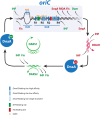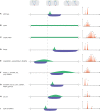Multiple DNA Binding Proteins Contribute to Timing of Chromosome Replication in E. coli
- PMID: 27446932
- PMCID: PMC4924351
- DOI: 10.3389/fmolb.2016.00029
Multiple DNA Binding Proteins Contribute to Timing of Chromosome Replication in E. coli
Abstract
Chromosome replication in Escherichia coli is initiated from a single origin, oriC. Initiation involves a number of DNA binding proteins, but only DnaA is essential and specific for the initiation process. DnaA is an AAA+ protein that binds both ATP and ADP with similar high affinities. DnaA associated with either ATP or ADP binds to a set of strong DnaA binding sites in oriC, whereas only DnaA(ATP) is capable of binding additional and weaker sites to promote initiation. Additional DNA binding proteins act to ensure that initiation occurs timely by affecting either the cellular mass at which DNA replication is initiated, or the time window in which all origins present in a single cell are initiated, i.e. initiation synchrony, or both. Overall, these DNA binding proteins modulate the initiation frequency from oriC by: (i) binding directly to oriC to affect DnaA binding, (ii) altering the DNA topology in or around oriC, (iii) altering the nucleotide bound status of DnaA by interacting with non-coding chromosomal sequences, distant from oriC, that are important for DnaA activity. Thus, although DnaA is the key protein for initiation of replication, other DNA-binding proteins act not only on oriC for modulation of its activity but also at additional regulatory sites to control the nucleotide bound status of DnaA. Here we review the contribution of key DNA binding proteins to the tight regulation of chromosome replication in E. coli cells.
Keywords: DNA binding proteins; E. coli; cell mass; chromosome replication; initiation synchrony.
Figures


References
Publication types
LinkOut - more resources
Full Text Sources
Other Literature Sources

